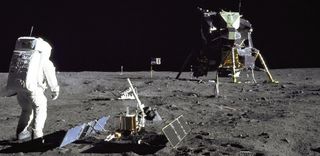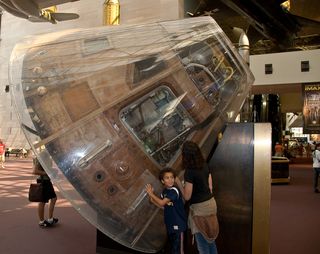
Look, But Don't Touch: U.S. Law and the Protection of Lunar Heritage (Op-Ed)

This article was originally published at The Conversation. The publication contributed the article to SPACE.com's Expert Voices: Op-Ed & Insights.
With India and China planning lunar surface missions, privately-funded space entrepreneurs competing for the US$40 million Google Lunar X Prize and discussions around lunar mining intensifying, working out what to do with our moon’s cultural heritage is becoming urgent.
In an article in the journal Science today, space lawyers Henry Hertzfeld and Scott Pace propose a multilateral agreement at the highest international level, initially between the US and Russia, but open to other moon-faring entities such as China, India and the European Space Agency (ESA).
And while there is much to recommend this, I propose we should consider extending the agreement idea further.
The moon has a rich archaeological record created by nearly 40 missions, from 1959 until the present. Most are robotic, but those that really grabbed the public’s imagination had human crews.
In 1969, at the site of Tranquility Base, humans set foot on another world for the first time. The Apollo 11 astronaut footprints in the thick lunar dust and the controversial flag are among the most iconic images of the 20th century.
Other missions include the USSR Luna series, which deployed two Lunokhod rovers. Wherever Russian spacecraft landed, they left medallions of Lenin and the USSR coat of arms.
Get the Space.com Newsletter
Breaking space news, the latest updates on rocket launches, skywatching events and more!
More recently, China, India, Japan and the ESA have started crashing spacecraft into the surface of the moon at the end of their mission life.
All up, there are more than 190 tons of artefacts from lunar exploration. Now, these sites may be under threat.
US law to the moon
In 2011, NASA created a set of voluntary guidelines for future missions to avoid damage to Ranger, Surveyor and Apollo sites.
These include measures such as no-go buffer zones, heritage “precincts” and recommendations about how to fly around sites to avoid stirring up destructive dust.
Another proposal, which emerged in July this year, has raised alarm bells. The Apollo Lunar Legacy Act, which is currently before US Congress, aims to declare a National Park on the moon specifically to ensure the protection of US heritage sites.
Space legal experts have pointed out that this is incompatible with the 1967 Outer Space Treaty (OST), to which the US is a signatory. The Outer Space Treaty forbids territorial claims in outer space, by any means – and this includes indirectly, such as the extension of national jurisdiction to space places, as we see here.
It’s not the first time this issue has come up. In 1999, archaeologist Beth Laura O’Leary, from the State University of New Mexico, and her team, catalogued all the material at the Apollo 11 site for the Lunar Legacy Project funded by NASA.

They proposed designating the artefacts a National Historic Landmark, as they were legally the property of the US under the Outer Space Treaty. Back then, NASA’s response was unequivocal: such a move risked being interpreted by the international community as making a territorial claim.
As well as the legal issues, the Apollo Lunar Legacy Act plays into aspects of US ideology that sometimes cause unease in the international community:
- manifest destiny (it is a moral duty of Americans to expand their territory)
- American exceptionalism (America is unique among nation states and not bound by the same rules)
- the cult of the American flag (the flag as the actual embodiment of the nation rather than just a symbol).
While this is obviously a simplification of more complex ideas, which are by no means universally accepted, elements of all three can be seen in the discourse around the significance of US lunar heritage sites.
All the same, everyone seems to agree that something needs to be done. Is the US bill the best option for the moment? Probably not.
The authors of today’s Science article, Hertzfeld and Pace, argue that a multilateral agreement would not violate the Outer Space Treaty, and would allow the interests of other nations to be represented.
The very sensitive issues around property and resource rights on the moon are side-stepped, leaving the way clear to effectively protect this precious heritage.
I suggest, though, that this proposal could go further. Hertzfeld and Pace limit the agreement to space-faring nations. But if we are to uphold the principle that space exploration is undertaken for the benefit of all humanity, then we need to broaden our view of who has contributed.

Looking Down Under
Let’s look at a couple of Australian examples. In the 1960s, the US used the Woomera rocket range in South Australia to test nose-cones on the Redstone rocket, a precursor of the Saturn V rocket which took astronauts to the moon.
The contribution of the Traditional Owners who were displaced to make way for the range may have been involuntary, but it supported the development of both US and European space industries.
Four of the five successful Apollo missions carried a dust detector experiment, designed by the University of Western Australia’s Professor Brian O’Brien. (The detectors gathered important data which can be used for comparison with new data from NASA’s recently launched LADEE spacecraft.)
No doubt there were many other hardware components designed or manufactured outside the US.
Australia might not be a space-faring nation, but it doesn’t mean we’re not stakeholders in lunar heritage. You can find many similar examples, such as the nations who hosted NASA tracking stations, a critical part of the Apollo programme.
Include more, not less
This kind of approach is consistent with United Nations declarations and principles, which call for space to be more inclusive. It also picks up on the recommendations of the Dublin Principles, created in 2011 by the International Council on Monuments and Sites and the International Committee for the Conservation of the Industrial Heritage. The Dublin Principles emphasise the importance of recognising networks and multiple locations.
A multilateral lunar heritage agreement could also serve as a model to address another issue that is even more urgent – international cooperation on actively removing hazardous orbital debris.
The extraordinary achievements of the US lunar exploration programme are undeniable. But heritage is inherently political. Whoever controls the past will have a huge influence on the shape of things to come.
Alice Gorman does not work for, consult to, own shares in or receive funding from any company or organisation that would benefit from this article, and has no relevant affiliations.
This article was originally published at The Conversation. Read the original article. The views expressed are those of the author and do not necessarily reflect the views of the publisher. This version of the article was originally published on SPACE.com.
Join our Space Forums to keep talking space on the latest missions, night sky and more! And if you have a news tip, correction or comment, let us know at: community@space.com.

Dr. Alice Gorman is an internationally recognized leader in the field of space archaeology. She is an Associate Professor in the College of Humanities, Arts and Social Sciences at Flinders University, where she teaches the Archaeology of Modern Society.
Her research focuses on the archaeology and heritage of space exploration, including space junk, planetary landing sites, off-earth mining, rocket launch pads and antennas.
She is a member of the American Institute of Aeronautics and Astronautics, the Advisory Council of the Space Industry Association of Australia and the Australian Institute of Aboriginal and Torres Strait Islander Studies.
Her book "Dr. Space Junk vs the Universe: Archaeology and the Future" (2019) won the Mark and Evette Moran NIB People's Choice Award for Non-Fiction and the John Mulvaney Book Prize, awarded by the Australian Archaeological Association. It was also shortlisted for the Queensland Premier's Literary Awards, the NSW Premier's Literary Awards, and the Adelaide Festival Literary Awards.
Alice tweets as @drspacejunk and blogs at Space Age Archaeology.
